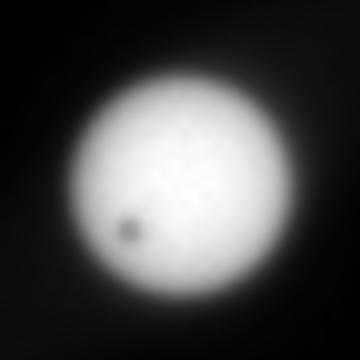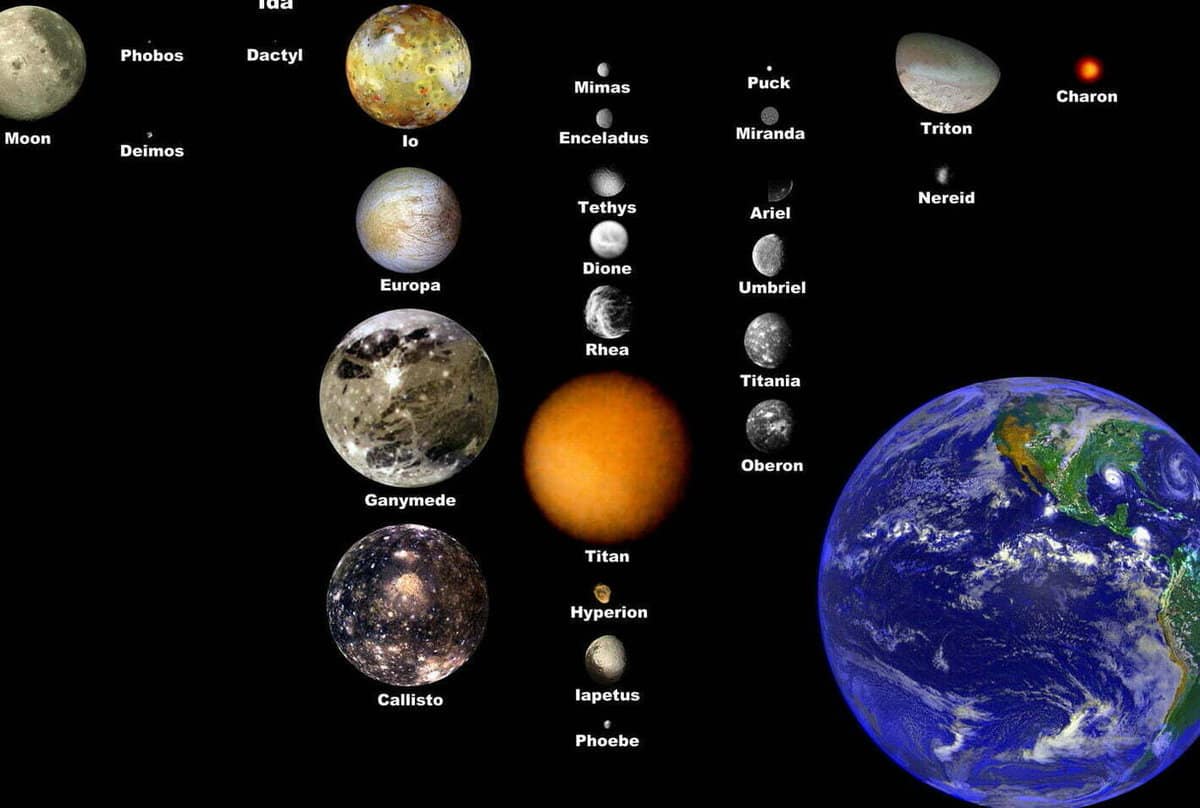The origin of Mars’ satellites, Phobos and Deimos, has been a mystery for planetologists for many years. “Hytek” explores the various theories and why one of the newest ones is unlikely.
Read “Hytek” on
Since their discovery in 1877, the small moons of Mars have puzzled astronomers. One of the biggest questions is how these unusual bodies were formed. Their irregular shapes and spiral orbits (with Phobos slowly approaching Mars and Deimos moving away from it) have given rise to numerous incredible hypotheses.
In the late 1950s, the Soviet academician Shklovsky put forward a hypothesis that Phobos is a man-made, hollow metal object. He was led to this idea by the peculiar spiral orbit of the satellite and the incorrect calculation of its density. Although this theory was quickly debunked, the mystery surrounding the origin of the Martian moons continues to intrigue scientists to this day.
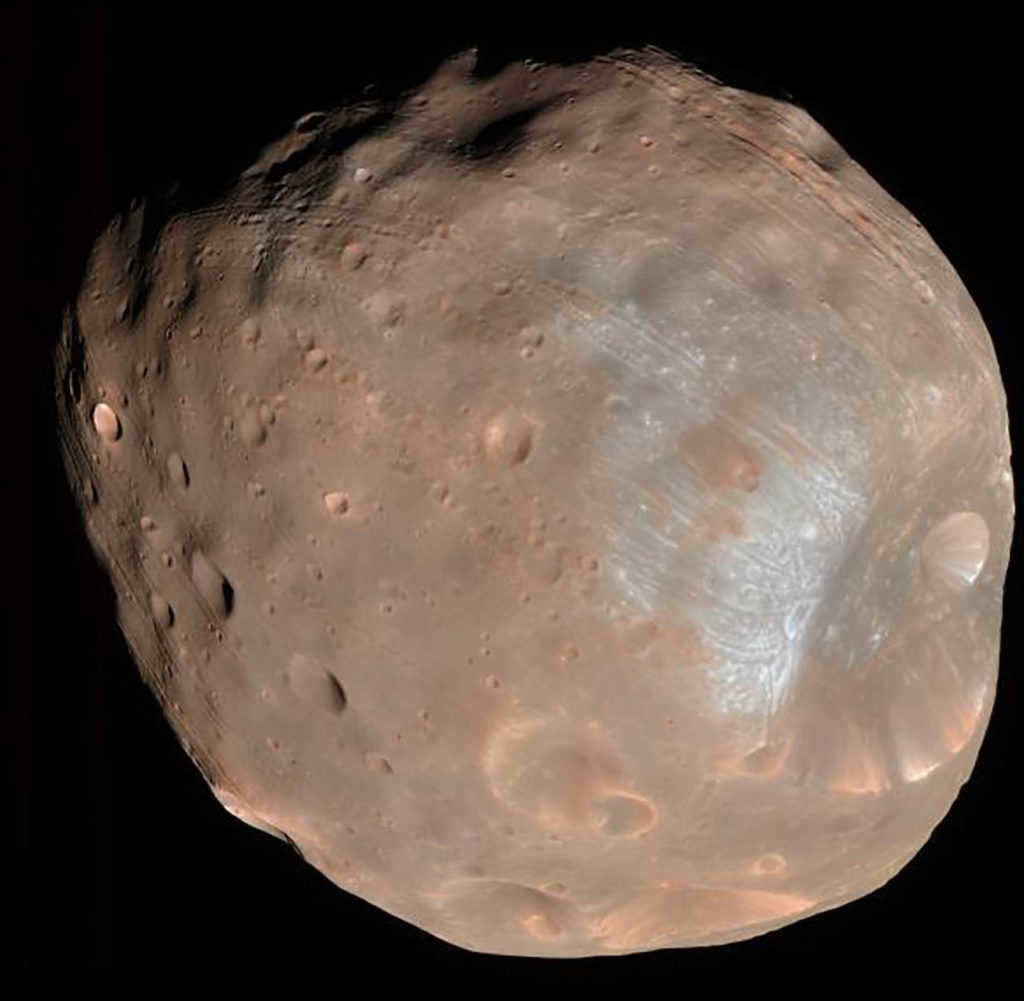
The second hypothesis proposes that Mars once possessed numerous moons comparable in size to Phobos and Deimos. These moons were propelled into orbit when Mars collided with a sizable planetesimal. This phenomenon is one of the celestial bodies that emerged during the gradual fusion of particles in the protoplanetary disk. It is postulated that a similar event involving Earth and a celestial body of similar proportions led to the formation of the Moon.
The collision in Mars’ orbit likely resulted in the formation of a ring composed of ejected materials. The inner section of this ring gave rise to a large satellite, while the gravitational interactions between this satellite and the outer ring eventually led to the formation of Phobos and Deimos. According to this theory, the inner moon eventually collided with the planet’s surface due to tidal forces.
Supporting this hypothesis are the purportedly high porosity and composition of Phobos. The calculated density of this moon implies that approximately 25 to 35% of its overall volume consists of empty spaces, which is atypical for asteroids. Furthermore, research conducted in the thermal infrared range has led scientists to deduce that its composition primarily consists of phyllosilicates, which are abundant on the surface of Mars but uncommon in known asteroid groups.
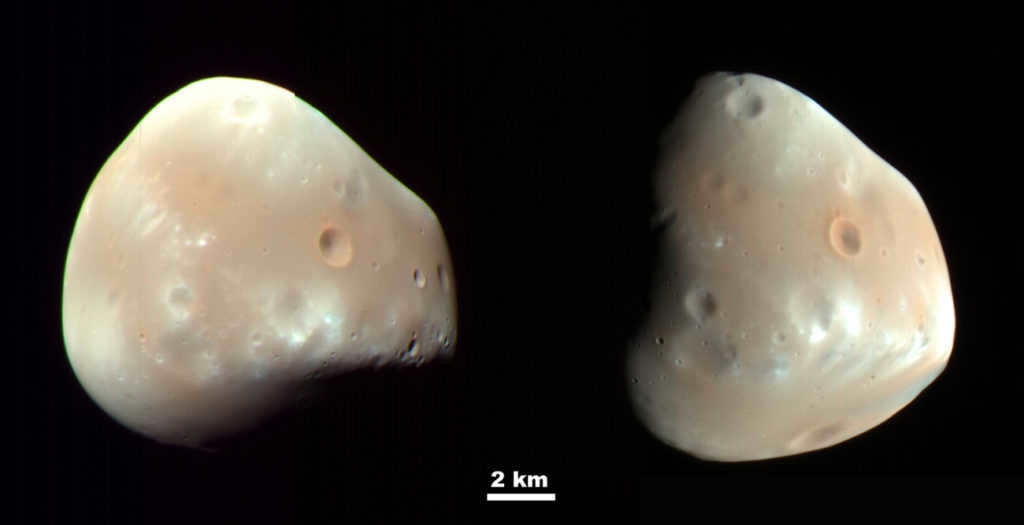
Origin with interruptions
A novel theory regarding the formation of Mars’ moons has been proposed by researchers from ETH Zurich and the U.S. Naval Observatory in 2021. By examining seismic and orbital data gathered from NASA’s InSight mission, planetologists have put forward the idea that Mars’ satellites may have originated from a collision between the ancient moon of the Red Planet and another celestial body. This impact event caused the primary satellite to break apart and give rise to the new moons, Phobos and Deimos.
According to this concept, it is theorized that the original satellite was ripped apart around 1 to 2.8 billion years ago. Alongside the possibility of an external impact, the hypothesis also suggests that tidal forces from the planet could have contributed to the satellite’s disintegration. Regardless of the cause, scientists have calculated that the destruction of the protosatellite led to the formation of a debris ring in its orbit, which eventually coalesced into two separate satellites due to numerous collisions.
This notion is supported by the observation that the orbits of Deimos and Phobos may have crossed paths in the past. Unlike the theory proposing a collision between Mars and a planetesimal, this concept provides a better explanation for the current orbits of the two satellites.
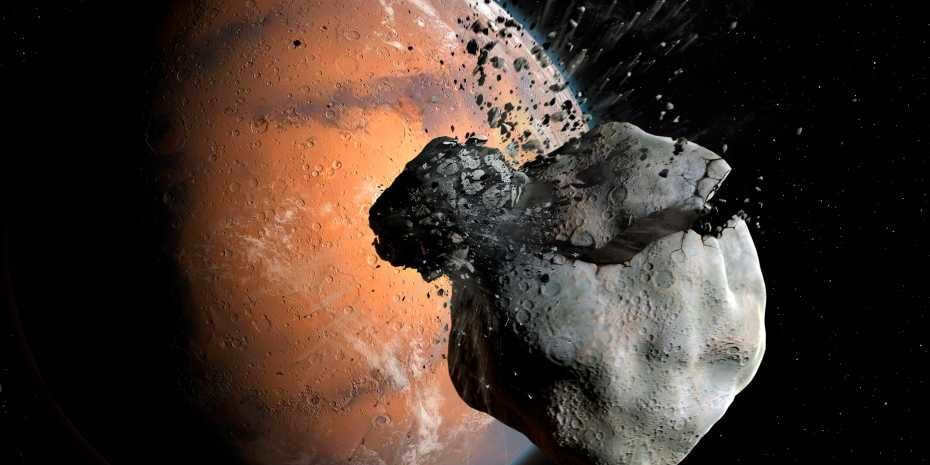
What were the findings of the recent research?
In order to test the proposed hypothesis, a group of scientists from the Institute of Space Research and Astronautics of Japan (ISAS) have constructed a computer model based on the theory that Phobos and Deimos were originally a single entity. The planetary scientists then conducted numerical simulations which combined geophysical models with the tidal evolution of the Mars-satellite system.
The study has revealed that the two moons were formed from a singular object and there is a 90% probability that they would have collided within a span of 10,000 years. This collision would have resulted in the complete destruction of both satellites, breaking them into smaller fragments. Consequently, a ring similar to those observed around Saturn would have formed around Mars. This ring would have endured to the present day.
However, there have been numerous observations indicating a lack of significant debris in the orbit of Mars apart from its two primary satellites. This particular model raises doubts about the theory of a sporadic origin for the Martian satellites.
Each of the three hypotheses put forth by researchers at different points in time offers a partial explanation for the processes that led to the formation of the satellites orbiting Mars. However, none of these hypotheses fully account for all the observations. It is possible that scientists could gain a better understanding of the origin of these peculiar moons if they were able to conduct further studies. Unfortunately, all attempts to send missions to Phobos have been unsuccessful thus far.
In 1988, the Soviet Union successfully launched two satellites as part of the Phobos program. However, both of these satellites encountered issues and were unable to land on the Mars satellites as originally planned. Another setback occurred in 2011 when Russia’s Phobos-Grunt probe failed due to equipment failure and burned up in the Earth’s atmosphere after entering orbit.
At the same time, the missions to Mars satellites that were being developed by NASA, the European Space Agency, and the Canadian Space Agency were all canceled.
Looking ahead, the Japanese Space Agency has announced its plans to send a mission to Phobos in the mid-2020s. This mission aims to collect soil samples from the satellite. With any luck, this mission will not encounter the same setbacks as previous attempts, and scientists may finally uncover the mysteries of how the Martian moons formed.
Read more:
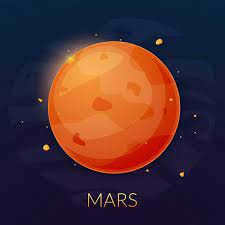
German astrophysicist Johannes Kepler proposed the idea of Mars having two companion bodies back in 1611. This hypothesis was based on a mention in Galileo Galilei’s writings of observations of a triple planet. However, it was later understood that this reference was actually describing Saturn with its iconic rings.
Despite the initial error, Kepler’s hypothesis turned out to be accurate. In honor of the astronomer, craters on Mars and the Moon have been named after him.
In 1726, Jonathan Swift included calculations of the physical parameters of Mars’ satellites in his book “Gulliver’s Travels”, even though they had not yet been discovered. These calculations were purely based on his imagination. The 8 craters on Phobos’ surface were later named after characters from this work.
Mythology
The first satellite was named after a Greek god who represented fear, while the second satellite symbolized terror. Both of these satellites were associated with the god of war, Ares, who the ancient Romans called Mars. Many people mistakenly believe that A. Hall named these bodies, but it was actually G. Madan who used characters from Greek mythology to give them their names.
Alternative hypothesis for the formation
There is another theory regarding the formation of satellites that suggests Mars was once surrounded by numerous objects similar in size to the satellites we see today. These objects were flung into orbit around Mars after colliding with a large planetesimal. The high porosity of Phobos (with a density of 1.88 g/cm3 and voids comprising 25-35% of its volume) does not support the idea that it originated as an asteroid.
Infrared observations of Phobos indicate that it mainly consists of phyllosilicates, which are commonly found on the surface of Mars. The spectral characteristics of Phobos differ from all types of chondrites, meteorites that come from asteroids. Based on this evidence, it is believed that Phobos formed from material that was ejected into Mars’ orbit as a result of a collision with an asteroid or another large celestial body.
Phobos is the second most extensively studied celestial body in the solar system, following the Moon. It orbits at a distance of 9377 kilometers from Mars. As it orbits around its parent planet, Phobos exhibits peculiar orbital effects, moving at a faster pace than Mars rotates on its axis.
Deimos, on the other hand, is the outermost moon of Mars and follows nearly circular paths in its motion. From the surface of Mars, Deimos appears to have an apparent diameter of no more than 2.5 minutes of arc, which is approximately 1/12th the size of Earth’s moon. It rotates slowly, gradually ascending from the east.
Physical attributes
Phobos is situated at a distance of 9,377 km from Mars. It has an initial orbital velocity of 7 m/s. The size of this celestial object is slightly smaller than that of a bustling metropolis. Phobos lacks an atmosphere and experiences low gravity due to its small mass. It reflects very little sunlight.
Spectroscopically, Phobos bears resemblance to a D-type asteroid, and chemically, it is similar to carbonaceous chondrites. Because of its low density, Phobos appears to be solid, yet it possesses a significant amount of porosity. These characteristics suggest the presence of ice deposits on the moon.
While the surface layer of Phobos does not contain H2O, it is possible that water exists beneath the regolith. The moon maintains a temperature of 233 degrees Kelvin.
Little Deimos shares similarities with C or D asteroids:
This non-spherical body measures 7.8 x 6.0 x 5.1 km and is composed of carbonaceous material.
The presence of holes on Deimos is not as noticeable as it is on Phobos. Deimos has a denser radar hull and a more porous surface. Therefore, the only differences between Deimos and Phobos are their orbits and sizes.
Asaph Hall’s Discovery of Mars’ Satellites
In the 16th century, observatories across Europe were perplexed by the absence of satellites around the neighboring planet. However, Deimos and Phobos were officially discovered on August 11 and 17, 1877, respectively, in the United States by Asaph Hall. This remarkable achievement occurred during a period of maximum convergence between our planet and its neighbor, which happens every 15 years.
Ongoing and Completed Research
The discovery and exploration of Mars’ satellites did not happen overnight. The first photographs were obtained in 1894, and S. Kostinsky’s works in 1896 further added to the list. In 1909, additional images were compared to draw conclusions, while in 1911, G. Struve proposed the first theory of their motion.
Multiple spacecraft have been sent on four missions to study the satellites Phobos and Deimos. Unfortunately, each mission encountered difficulties. Some vehicles failed to reach their destination, while others couldn’t even leave Earth’s orbit. As a result, most of the missions were left incomplete. However, despite these setbacks, research on Mars’ satellites continues to this day.
The detection and demise of the Mars satellites
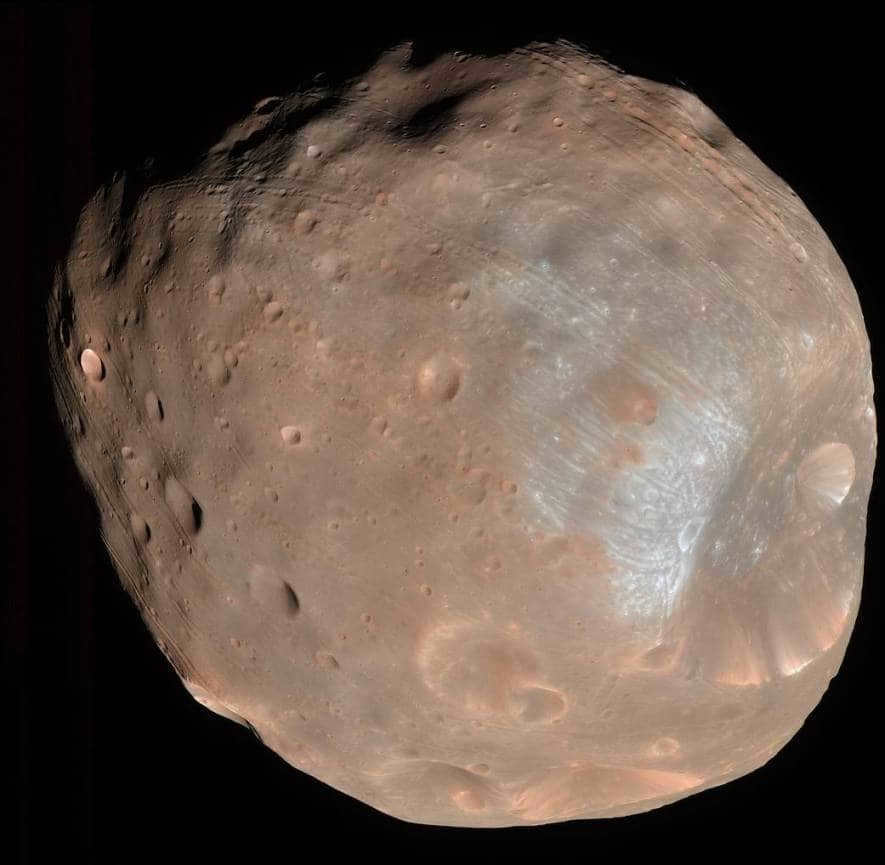
For a considerable period, scientists believed that Mars was a solitary planet. Johannes Kepler initially proposed the possibility of the existence of satellites around Mars. However, his hypothesis was based purely on mathematical calculations. In 1877, Asaph Hall conducted an extensive investigation and successfully discovered two moons orbiting Mars, namely Deimos (on August 12) and Phobos (on August 18).
The names of these moons are derived from Ares, the god of war in Roman mythology, which is the equivalent of Mars in their culture. Phobos is named after the Greek word for fear, while Deimos is named after the Greek word for panic. However, Mars will not always have these moons as its companions. Every century, Phobos gradually moves closer to Mars at a rate of 1.8 meters per year. In approximately 50 million years, it is predicted that Phobos will either collide with Mars or be disintegrated due to the planet’s gravitational forces.
How the Martian satellites received their designations
The official designations for Phobos and Deimos were established in February 1878, following an extensive search by Hall for suitable names. Throughout his quest, he corresponded with numerous figures in the scientific community, ultimately selecting the suggestion put forth by Henry George Madan. Interestingly, Madan derived his proposal from Homer’s epic poem, the Iliad. Alternatively, it is speculated that these designations were recommended by an unidentified student hailing from the United Kingdom.
Many celestial bodies in our solar system, including asteroids and stars, have names derived from ancient mythology. The fourth planet from the Sun, known as the Red Planet, is named after the ancient Roman god of war. In Greek mythology, this god was known as Ares. Despite representing qualities like cruelty, strength, and a love for war, Ares was highly revered. It is fitting, then, that the moons of Mars are named after the sons of this war god.
In Greek mythology, Ares was always accompanied by his children with Aphrodite during battles. This explains why the two moons of Mars are named Phobos and Deimos, which mean fear and terror, respectively.
Observing the Martian Surface
The view from the surface of Mars reveals distinct appearances of its satellites.
- Phobos. When observing Phobos, one can notice that its diameter is one-third the size of the moon as seen in the night sky. Its visual magnitude is 9. It rises in the west with Mars situated on its eastern side. It reappears after 11 hours, making two crossings across the Martian sky each day. The swift movement of this moon can be observed, and its phase changes are noticeable during this period.
- Deimos. Its rise takes place in the eastern sky. In terms of appearance, this moon of Mars resembles a brilliant star, lacking a discernible disk. Its visual magnitude index is measured at 5 units, indicating that it shines brighter than Venus. In general, the appearance of this celestial body is similar and comparable.
The moons of Mars can be observed simultaneously, and in the night sky, they will approach each other. The brightness of both satellites is sufficient for them to cast faint shadows on the surface of the main planet.
The revolution of both bodies around the planet’s surface is quite close, and this process is also characterized by a slight tilt of the orbit with respect to the equator. These factors make observations at high latitudes in the north and south more challenging.
How many moons does Mars have
The number of moons orbiting Mars remained a mystery until 1877. Despite the calculations made by astronomers, which indicated the presence of celestial bodies around the planet, it was widely believed that Mars had no natural satellites, as none were observable. The discovery of these objects caused a great stir in the scientific community.
It has since been established that the planet Mars has two natural moons known as Phobos and Deimos. The former is situated in the inner orbit of the planet at an average distance of 9380 kilometers, while the latter is located two and a half times further away.
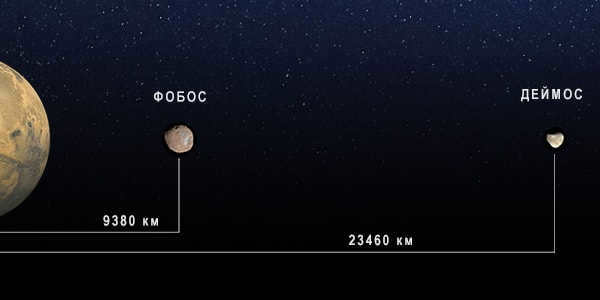
The distance between Mars and its satellites
Phobos
Phobos is the inner natural satellite of Mars, located at a distance of 9380 km. This moon is visible in the Martian sky three times a day, moving from west to east. It has dimensions of 26.8 × 22.4 × 18.4 km. Despite its proximity to Mars, it appears three times smaller than our Moon seen from Earth.
The surface of the satellite bears marks of encounters with small asteroids and comets, with some grooves and craters being notably deep and wide as a result of the satellite’s porous composition. Based on NASA’s official calculations, the soil structure contains voids that can reach up to 45%. The most prominent crater on Phobos is named Stickney Hall, after the wife of the person who first discovered the Martian moons. This crater is so vast that it can be observed without the aid of any instruments from Mars. Within Stickney lies a smaller crater, which is considerably younger than its predecessor.
Deimos
Deimos is the smaller of the two natural satellites of Mars, measuring 15 × 12.2 × 10.4. It is located at a distance of 23460 km from Mars, twice as far away as its sibling Phobos. Deimos has a similar shape to Phobos but is much smaller and has a smoother surface.
Deimos orbits Mars from east to west once a day. It can be seen as a white star in the sky, similar to how Venus is seen from Earth, even during daylight hours.
Deimos and Phobos orbit Mars in sync, causing them to only be visible from one side of the planet’s surface. This type of movement is common among natural satellites in our solar system. However, even with this understanding of how space objects interact, tidal forces still impact these bodies. This results in phenomena like Earth’s tides or the yearly approach of Phobos to Mars, coming as close as 10 cm.
Characteristics of Structure and Structural Composition
The composition of the satellites of Mars, namely Phobos and Deimos, primarily consists of rocky materials. A consistent layer of regolith covers their surfaces. Phobos, the first satellite, has an uneven surface as it was formed from the accumulation of meteorite impacts or the deposition of material that fell onto the “red planet”. Deimos, the second satellite, appears smoother in appearance because most of its craters are covered by fine-grained material.
Mars’ Impact on Satellites
The gravitational pull of Mars has a significant influence on its natural satellites, causing them to become tidally locked and consistently face the same direction, similar to Earth’s moon. The rotational motion of Phobos is affected by centripetal acceleration, resulting in a reduction of its orbit’s radius due to tidal forces. Scientific evidence suggests that as Phobos draws closer to Mars over time, these tidal forces will eventually tear apart the Martian moon. This probability is supported by the presence of deep craters on Mars’ surface, indicating the likelihood of numerous small satellites in the planet’s history.
Deimos, on the other hand, which is located farther away from Mars, experiences a gradual expansion of its orbit. This phenomenon is comparable to the interaction between the Moon and Earth.
Interesting details about Deimos
The moon Deimos is almost half the size of Phobos. It was also discovered in 1877 by the same American astronomer Asaph Hall. It was named after Deimos, the ancient Greek god of fear. It is situated at a distance of 23.5 thousand kilometers from Mars, which is significantly further than Phobos. The surface of this satellite is smooth, however, it does have two craters. The first one is called Swift and has a width of 1000 meters. The second crater is named Voltaire and has a width of 1900 meters.
Exploring the Satellites of Mars
Up until now, no specific missions have been dedicated to studying the satellites of Mars. However, a spacecraft that recently arrived at Mars has been able to capture images of both the planet and its satellites while orbiting. The first mission to do so was Mariner 9 in 1971, which successfully captured images of these objects from a significant distance.
Other missions that have made similar observations include Viking (1970-1980), Soviet Phobos 2 (1980), Mars Global Surveyor (1990), Mars Express (2000), and MAVEN. While the Mars rovers are limited to exploring the planet’s surface and are unable to reach the satellites, they do have the capability to capture images from unique angles. This feat has been accomplished by Spirit, Opportunity, and Curiosity.
Details about Mars’ Satellites
| Name | Dimensions (km) | Weight (kg) | Orbit (km) | Orbital Period (h) | Travel Speed (km/s) |
| Phobos | 22.2 km (27 × 21.6 × 18.8) km | 10.8 × 10^15 | 9377 km | 7.66 | 6.2 |
| Deimos | 12.6 km (10 × 12 × 16) km | 2 × 10^15 | 23,460 km | 30.35 | 3.94 |
Explorations and discoveries
During his endeavors, U. Herschel made an attempt to unveil the satellites of Mars. This pursuit took place in 1783; however, no fruitful outcome came to fruition. In 1830, I. Heinrich undertook similar searches, but alas, no novel findings were unearthed. The official revelation of celestial bodies took place on August 11 and 17, 1877, courtesy of A. Hall. Throughout his observations, he utilized a 66 cm and 26-inch refractor telescope, which, during that period, stood as the largest apparatus in the world.
Behold the panoramic depiction of the Martian moon Deimos. The images were captured circa 10 p.m. local time on Mars, or 8 a.m. Coordinated Universal Time in January.
Building Design
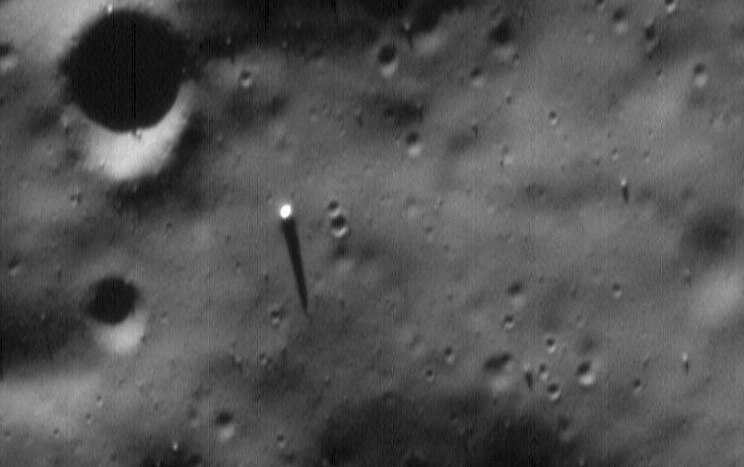
The tallest of the monoliths on Phobos measures approximately 85 meters in height, towering above the nearby terrain.
Based on information regarding its mass, density, and composition, the structure of Phobos is comparable to that of small asteroids. However, Phobos is unique in its low density, suggesting that it is primarily comprised of loosely held rocks held together by the satellite’s weak gravitational pull. The surface of Phobos is covered by a layer of regolith that spans 100 meters and is marked by numerous craters.
Origin of the Martian moons
Astrophysicists believe that the origin of the Martian moons can be attributed to a massive impact with an unidentified cosmic object. It has been determined that a colossal asteroid crashed into the planet, creating a crater on the plains of Ellados. According to this theory, the impact was so intense that the asteroid actually passed through the planet, emerging in the Northern Hemisphere. This event not only caused significant changes to the surface and composition of the soil, but also resulted in the expulsion of debris and tons of dust containing heavy metal particles into outer space. Consequently, these natural space remnants came together to form one or two bodies, which eventually fell under the gravitational influence of Mars.
According to an alternate perspective, the two ellipsoidal moons of Mars, Phobos and Deimos, came into existence simultaneously with the planets of our solar system, originating from cosmic dust. This theory suggests that Mars and its satellites existed within a self-contained system, forming their own unique microenvironment.
According to the commonly held belief, Phobos and Deimos were originally wandering asteroids of the S-type. They drifted closer to the Sun, passing through the space between Mars and Jupiter, and eventually came under the gravitational pull of the planets, ultimately falling into orbit around Mars. However, the chances of two celestial bodies being captured in this way simultaneously are exceedingly low, leading to the proposal of an alternative theory. This alternative suggests that Phobos and Deimos were actually a single entity. It is possible that they were once a part of the Trojan group of asteroids, which were then captured and subsequently destroyed by the gravitational forces of Mars.
There are scientists who believe that the satellites of Mars could be spaceships. One strong supporter of this theory was the Soviet astrophysicist I.S. Shklovsky. In his writings, he referred to the physical characteristics of Phobos, suggesting that it was actually an abandoned spacecraft from an extraterrestrial civilization. He argued that the object was hollow inside and that the surface damage was not caused by a meteorite collision, but rather by a deliberate bombardment that caused it to fall into disrepair. He fought for the declassification of all the data collected by NASA’s spacecraft during satellite exploration to support his claims. In honor of his contributions to the field and his research on the origin of celestial bodies, a crater on the surface of Phobos was named after him.
Until now, the precise origin of the satellites has remained elusive, just as the causes behind the formation of the Moon or the entire solar system as a whole cannot be definitively stated.
Mars’ Satellites: Phobos
Named after the ancient Greek god of fear, Phobos swiftly orbits the planet, completing three revolutions around Mars in a Martian day (the time it takes for Mars to rotate around its axis). With a diameter of 27 km, Phobos is situated very close to the planet’s surface (approximately 9400 km from the satellite to the planet), allowing Mars’ gravity to gradually decelerate its speed. It is projected that within a relatively short cosmic timeframe, Mars will eventually disintegrate the satellite due to the force of its gravity. This event is estimated to occur in approximately 7.5 billion years.
The third moon of Mars, Thanatos
The orbital behavior of Phobos suggests that it may be on the brink of destruction. It has already reached a critical point in its orbit known as the Roche limit. At this position, it is constantly being pulled by the gravitational forces of the planet and its range of motion is diminishing. If this process continues, it could result in either an explosion or the satellite crashing onto the surface of Mars. Both scenarios would have irreversible consequences for the red planet, ranging from changes in its geologic map to partial destruction. Regardless, Phobos is not expected to meet its demise for at least another 12 million years. The observations of this phenomenon have led to the development of the concept of three moons orbiting Mars.
According to astrophysicists, there is a belief that Mars had a third satellite that was situated closer to the planet and crossed the Rocha boundary, resulting in its demise. This alleged celestial body was given the codename Thanatos, after the ancient Greek god of death, who was highly revered in Sparta. Thanatos was known for his mercilessness and ruthlessness towards all living creatures. This myth represents one possible scenario that took place millions of years ago.
One of the most conventional theories suggests that the demise of Thanatos led to the annihilation of all life on a neighboring planet, altering its terrain, obliterating its atmosphere, and transforming the twin Earth into an inhospitable cosmic wasteland. However, these are merely speculative conjectures put forth by proponents of the idea of human colonization on Mars.
It is evident that the examination of the red planet’s satellites remains speculative and theoretical at present. However, delving deeper into their analysis has the potential to revolutionize the fields of cosmology and astrophysics. Unfortunately, the timeline for when such advancements might occur remains uncertain.
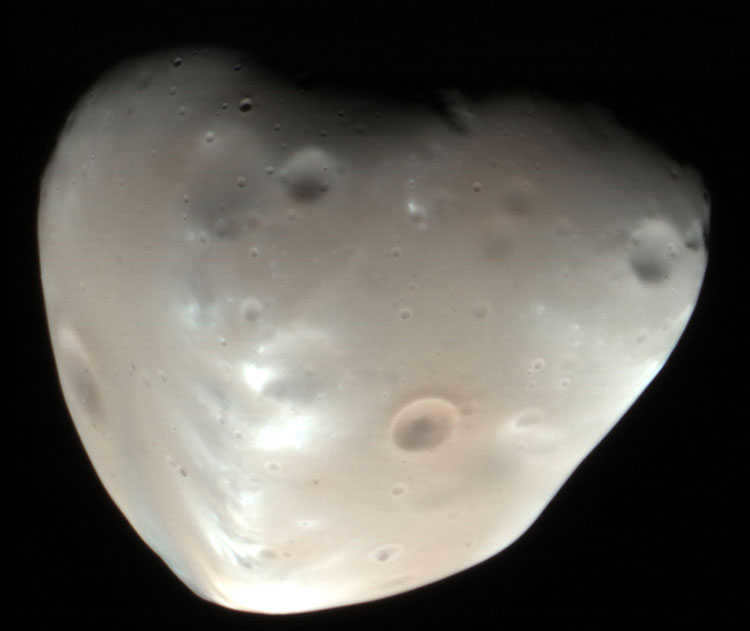
Deimos, the smaller of the two natural satellites orbiting Mars, has an average radius of 6.2 kilometers. It takes Deimos approximately 30.3 hours to complete a full revolution around the planet. In Greek mythology, Deimos was known as the god of “Terror” and was the twin brother of Phobos.
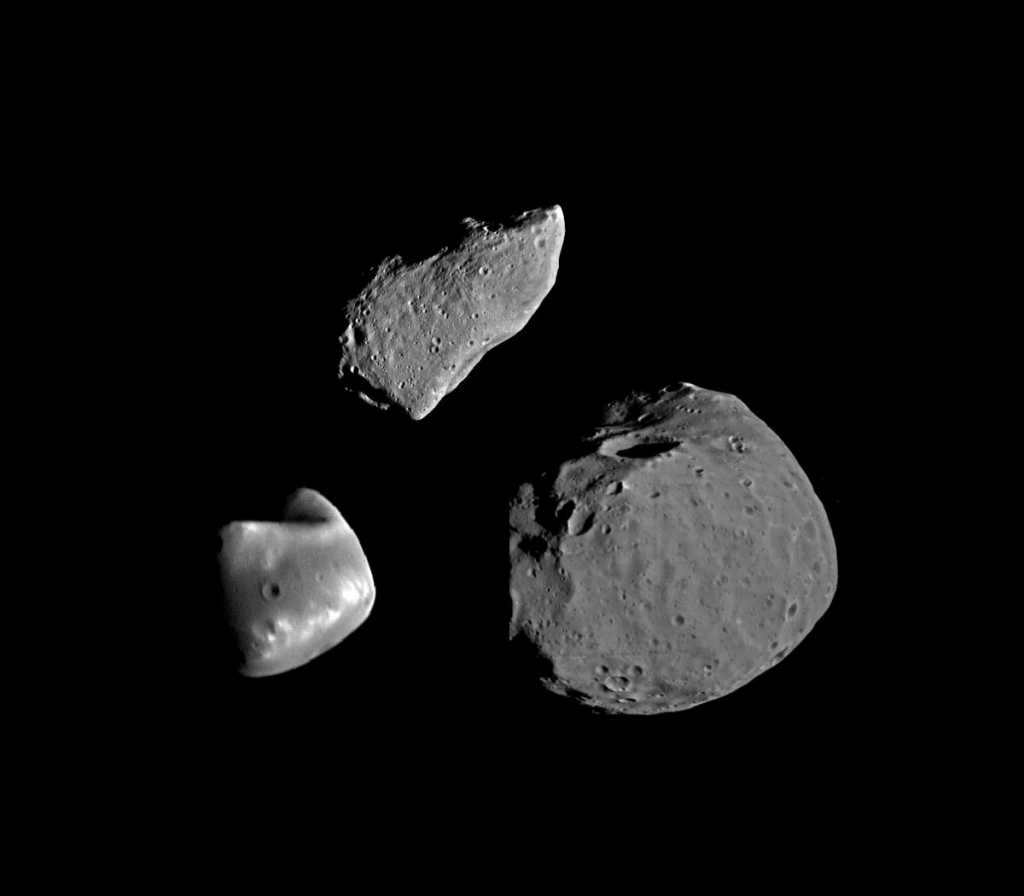
Asteroid Gaspra, Phobos, and Deimos
Deimos, the smallest of Mars’ moons, shares similar spectral, albedo, and density properties with C- or D-type asteroids. Similar to other celestial bodies of its size, Deimos is not perfectly spherical and measures 7.8 x 6.0 x 5.1 km, making it 0.56 times smaller than Phobos. Its composition consists mainly of carbonaceous material, resembling C-type asteroids.
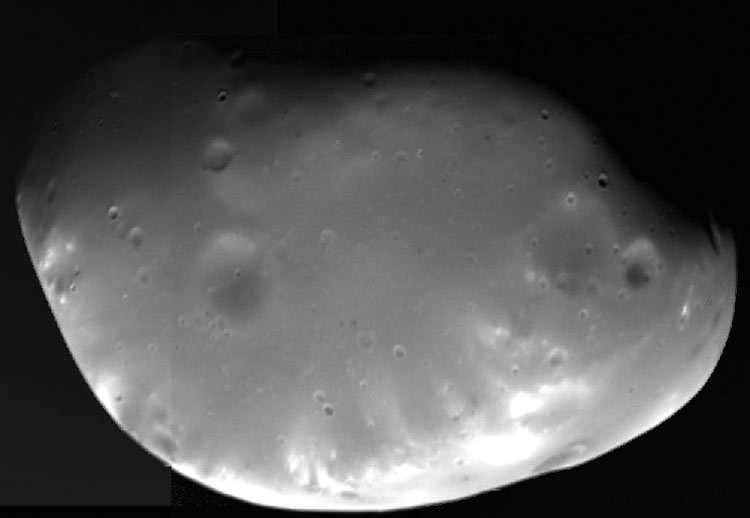
The Viking orbiter captured an image of Deimos in 1970. Its surface features craters that appear smoother than those on Phobos due to the presence of regolith filling the craters. This regolith is highly porous and has a radar density estimated to be 1.471 g/cm3. Overall, the differences between Phobos and Deimos are relatively minor, with orbit and size being the primary distinguishing factors.
Fascinating trivia
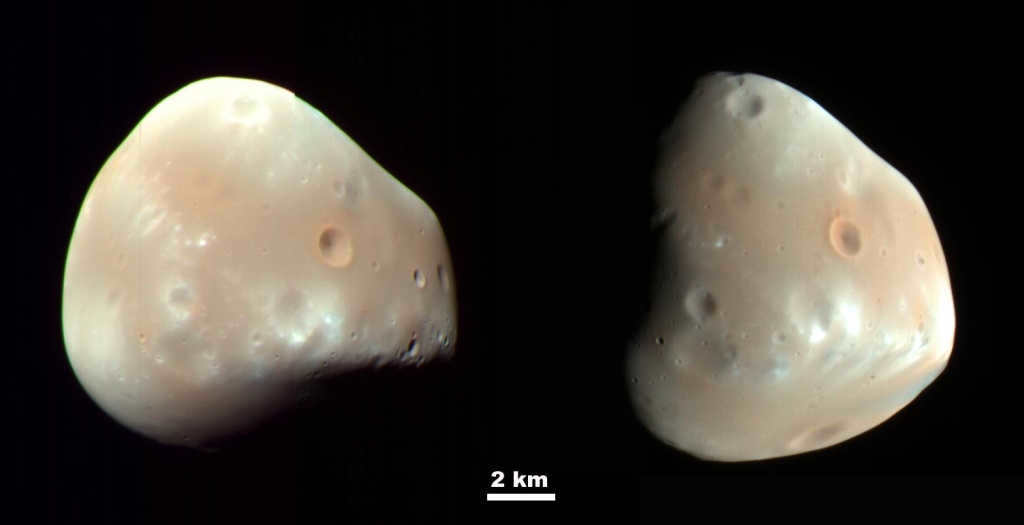

This high-resolution photo captures the intricate details of the satellite.
Among the remarkable features of this satellite are its two largest craters – Swift and Voltaire. Swift crater spans approximately 1 kilometer, while Voltaire crater measures about 2 kilometers in diameter. In terms of velocity, the satellite has a second space velocity of 5.6 m/s and an orbital velocity of 3.94 km/s, which is relatively low compared to its counterpart, Phobos. Additionally, the satellite has an apparent stellar magnitude of 12.45 and is situated at a distance of 23,460 kilometers from Mars.
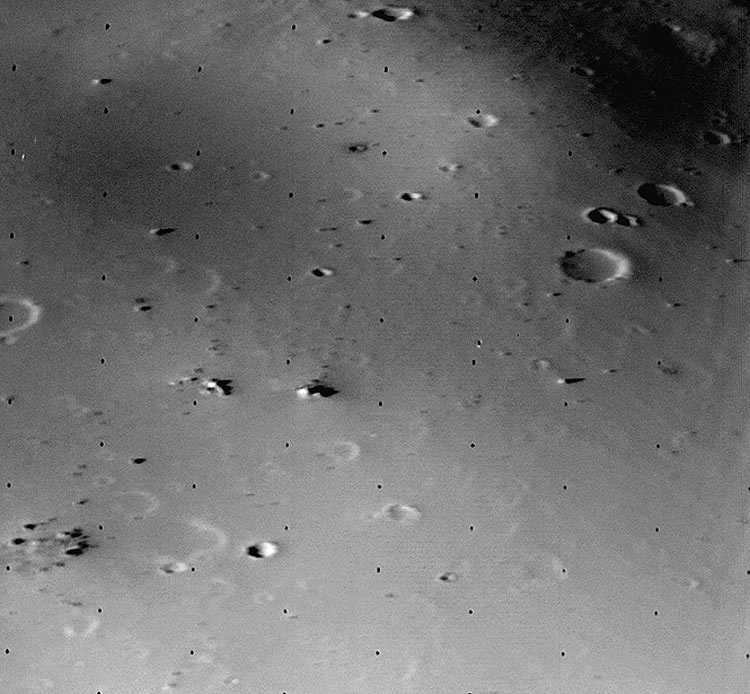
The Viking spacecraft took a photo of the surface of Deimos in 1977.
Only two craters on Deimos have been given names. These craters, Swift and Voltaire, were named after writers who wrote about the existence of two Martian moons in their works before astronomers discovered them.
| Crater | Named after | Diameter (m) |
| Swift | Jonathan Swift | 1000 |
| Voltaire | Voltaire | 1900 |
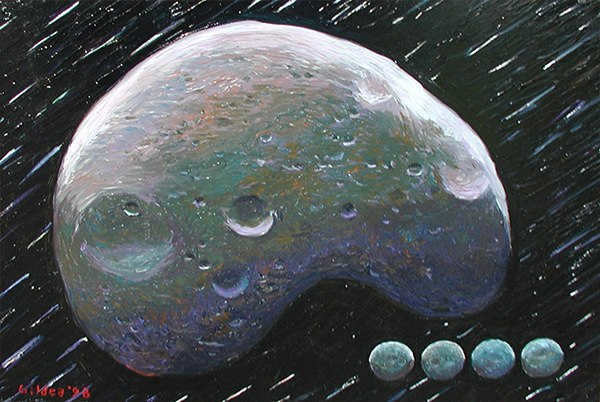
Deimos, illustrated by Steve Glidea
Orbital characteristics
The orbit of Deimos is almost circular and is located close to the equatorial plane of Mars. Deimos, the outer moon of Mars, is potentially an asteroid that was captured by Mars, although this theory is a subject of debate. The moons have orbits that are nearly circular and are situated in the equatorial plane of Mars.
Phobos travels in front of Deimos
When viewed from the surface of Mars, Deimos appears as a bright star or planet, with an angular diameter of no more than 2.5 angular minutes. This makes it about one-twelfth the size of our Moon. Its brightness is similar to that of Venus when seen from Earth. By using a small telescope, a Martian would be able to observe the phases of Deimos, which go through changes over a period of 1.2648 days (known as Deimos’ synodic period).
In contrast to Phobos, which spins rapidly, Deimos has a slower rotation and can be seen rising in the east and setting in the west.
Due to its proximity to Mars and its slight inclination to the planet’s equator, Deimos cannot be seen from Martian latitudes above 82.7 degrees.
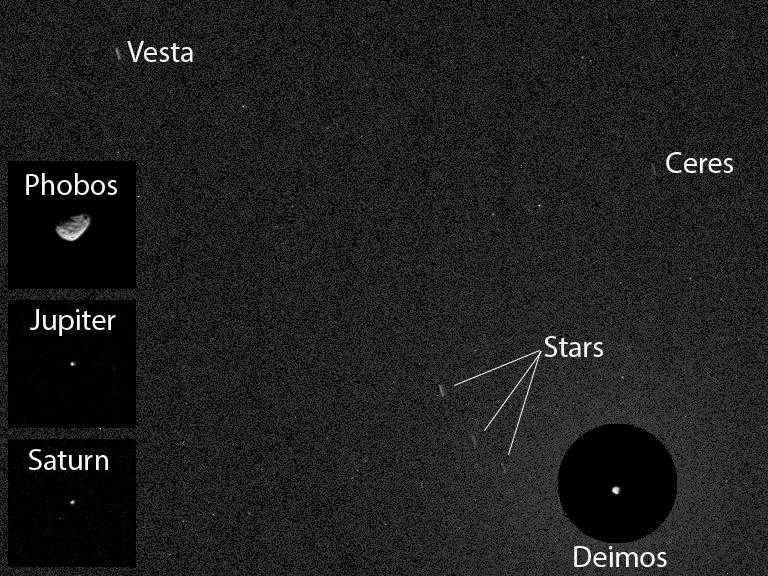
During a 12-second exposure, the Mastcam of the Curiosity rover captured stunning images of Ceres, Vesta, and Deimos!
Amateur astronomers have the opportunity to observe Deimos through their telescopes from Earth, as its stellar magnitude is 12.45 (and Phobos – 11.6), which falls within the capabilities of amateur equipment. However, due to their close proximity to Mars, it can be challenging to observe the Martian satellites.
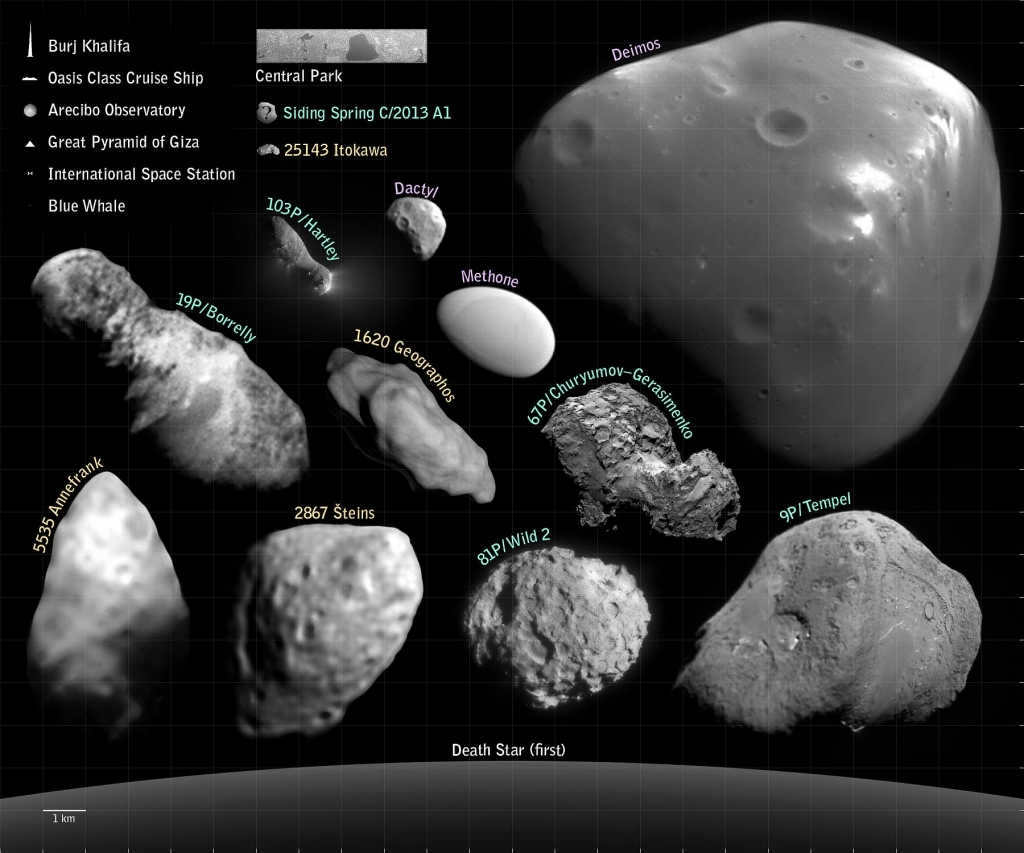
Comparison of Deimos and other objects: comets, asteroids, formations, and the Death Star
Solar transits
Deimos regularly undergoes solar transits, which can be easily observed from the Martian surface. It is too small to cause a total eclipse and appears as a small black dot moving across the Sun. Its angular diameter is approximately 2.5 times that of Venus.
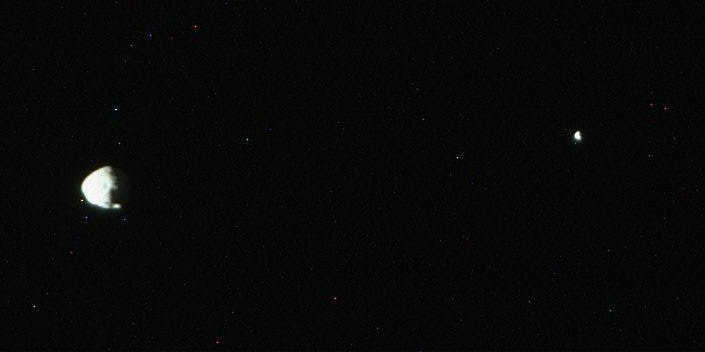
A photograph taken by the Curiosity rover on August 1, 2013 displays both of Mars’ satellites, Phobos and Deimos, in a single frame!
The Opportunity rover captured the transit of Deimos on March 4, 2004, and the Spirit rover also photographed it on March 13, 2004.
Did you enjoy the video? Share it with your friends!
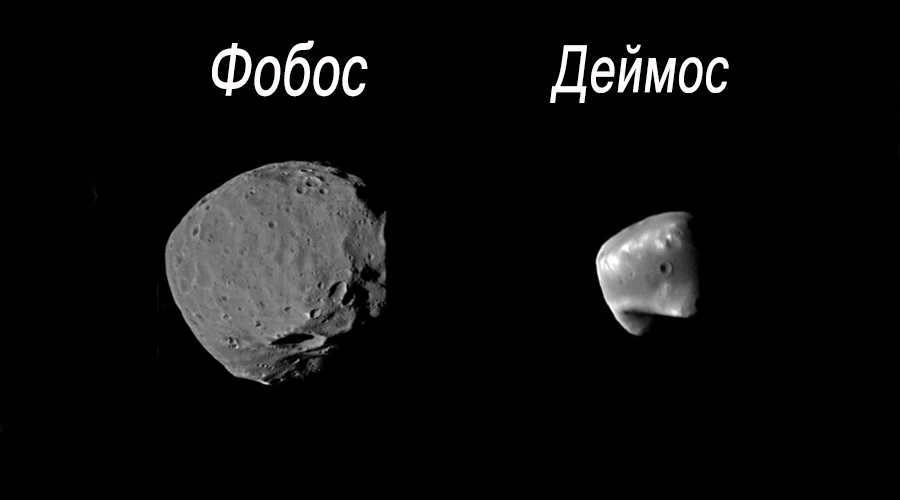
Mars is home to two satellites, Deimos and Phobos, which are thought to have been captured from asteroid origins. These two satellites were first spotted in 1877 by Asaph Hall and were subsequently named after Greek gods. There is a possibility that Mars may have even smaller satellites, measuring less than 50 to 100 meters in diameter, and a ring of dust nestled between Phobos and Deimos. However, as of now, none of these additional features have been confirmed.
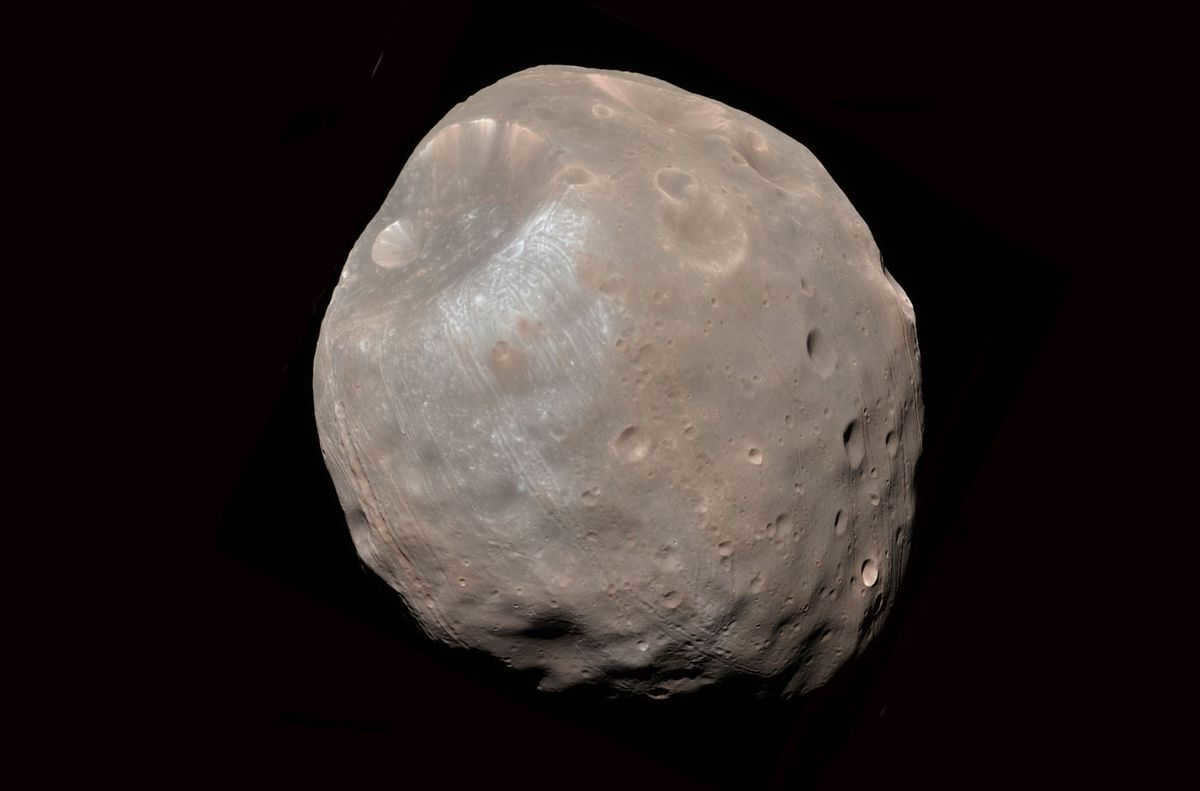
On August 12, 1877 at around 7:48 UTC, Asaph Hall, the astronomer who famously discovered the moons of Mars, first spotted the moon Deimos. He made this discovery at the U.S. Naval Observatory in Washington, D.C. Continuing his search for Martian moons, Hall then found Phobos on August 18, 1877 at approximately 9:14 UTC. Hall used a 66 cm refractor telescope to make these groundbreaking observations. The telescope was later relocated and housed in a new dome in 1893, where it remains today.
Mythological Satellites

Obtained by the MRO spacecraft in 2008, this image showcases Deimos.
Deimos, the Greek god of terror, and Phobos, the Greek god of fear, accompanied their father Ares, who was known as Mars to the Romans, into battle.
Although many people attribute the naming of Mars’ satellites to Asaph Hall, it was actually Henry Madan who suggested the names, which were inspired by Greek mythology.
Observability of the spacecraft from Mars
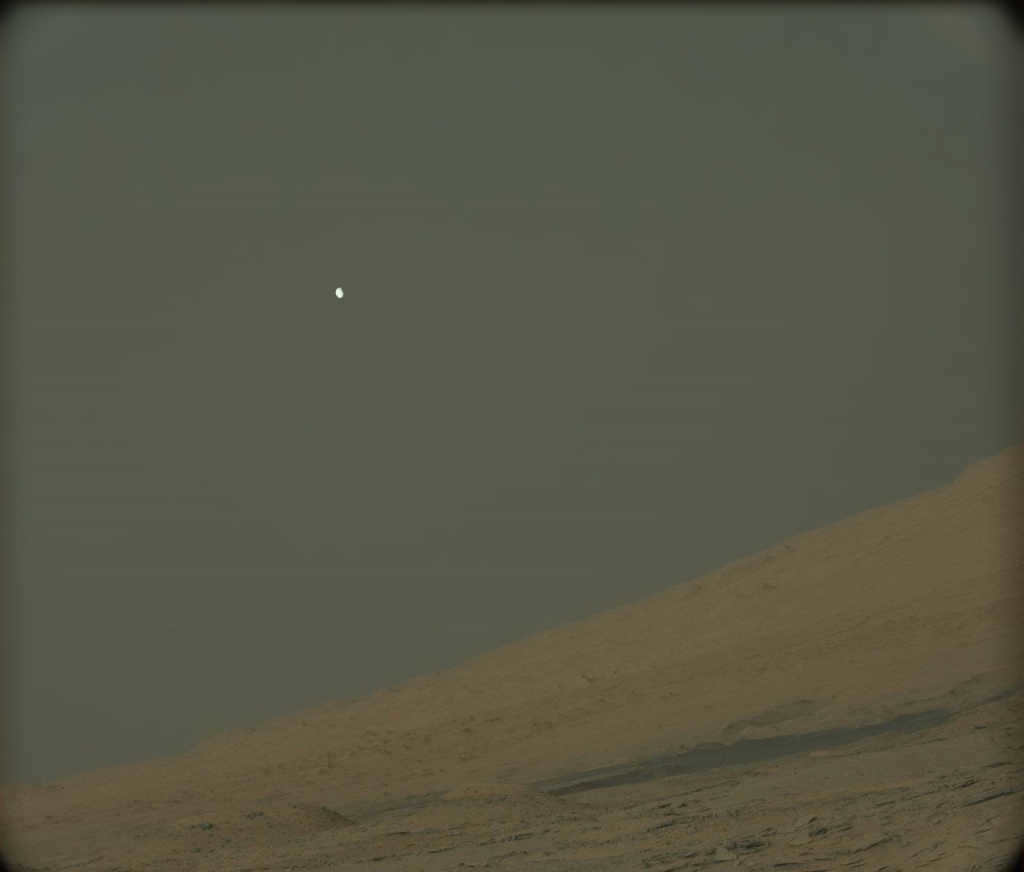
Mount Sharp’s mountain serves as a hiding place for Phobos
When observed from Mars’ surface, the satellites are easily noticeable. To catch a glimpse of them, one must be in close proximity to the planet’s equator, where Phobos appears to be about one-third of the size of Earth’s moon. It measures 8 by 12 angular minutes. From a greater distance away from Mars’ equator, Phobos appears smaller and becomes completely invisible (as it is always below the horizon) in the vicinity of Mars’ polar caps.

On August 1, 2013, the Curiosity rover captured an image that displays both of Mars’ satellites, Phobos and Deimos, in the same frame!
When observed from Mars, Deimos appears like a bright star or planet. It is slightly larger and brighter than Venus in Earth’s sky, with an angular diameter of approximately 2 minutes. In comparison, the angular diameter of the Sun on Mars is around 21 angular minutes. This means that complete solar eclipses, as seen on Earth, do not occur on Mars since the satellites are not large enough to completely cover the solar disk. However, partial solar eclipses caused by Phobos (or you could even say a transit across the Sun’s disk) are very common and happen almost every night.
Organization
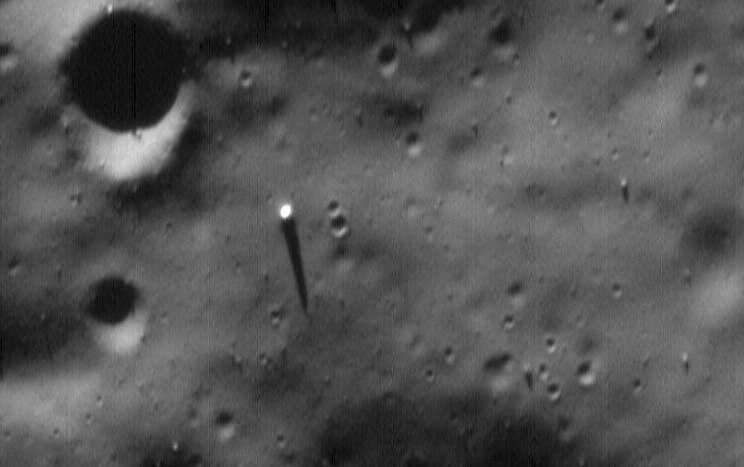

Phobos is home to a series of Monoliths, with the largest one towering approximately 85 meters above its surrounding landscape.
When considering the mass, density, and composition data, it becomes clear that the satellites have a structure that closely resembles that of small asteroids. However, due to Phobos’ low density, it is believed that these Monoliths are more like a collection of rocks that are held together by the weak gravity of the satellite. The surface of the Monoliths is covered by a layer of regolith that spans approximately 100 meters and is heavily marked by craters.
Phobos and Deimos: Fascinating Trivia
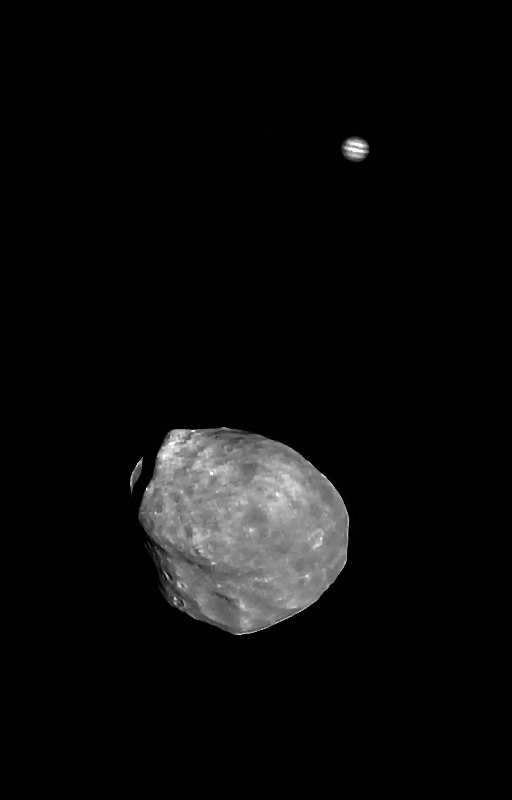
The movements of Mars’ satellites differ significantly from those of our own Moon. Phobos emerges in the western horizon and sets in the eastern horizon, completing one rotation in just 7 hours and 40 minutes. In contrast, Deimos, which is located near a synchronous orbit, also rises in the east but at a much slower pace. Despite its 30-hour orbit, it takes 2.7 days for Deimos to disappear below the western horizon in the Martian sky. The inclination of Phobos and Deimos’ orbits relative to Mars’ equator is approximately 1 degree. These small moons have relatively low masses, with Phobos weighing 10 kilograms and Deimos weighing 2×10*15 kilograms.
Mars’s Impact
Phobos crosses in front of Deimos
Mars’s natural moons are tidally locked to the planet due to its gravity (similar to our Moon) and always show the same face. As Phobos orbits Mars at a faster pace than the planet itself, the gravitational forces gradually decrease the size of its orbit.
In the future, when Phobos gets close enough to Mars, the tidal forces will eventually tear it apart. The presence of numerous craters near the equator of Mars suggests that the planet might have had several other small moons that met the same fate as Phobos, causing the Martian crust to shift. Deimos, on the other hand, is positioned at a significant distance from the planet, and its orbit is continuously expanding, similar to our Moon.
Details about the Martian Satellites
| Name | Dimensions (km) | Mass (kg) | Major semi-axis of orbit (km) | Circulation period (ч) | Velocity in km/s |
| Phobos | 22.2 km (27 × 21.6 × 18.8) km | 10.8 × 10 15 | 9.377 km | 7.66 | 6,2 |
| Deimos | 12.6 km(10 × 12 × 16) km | 2 × 10 15 | 23.460 km | 30.35 | 3,94 |
Source

Asteroid Gaspra, Phobos and Deimos
The origin of the Martian moons remains a topic of debate. The composition and appearance of the moons closely resemble C-type carbonaceous asteroids, with similar spectra, albedos, and densities. As a result, the prevailing theory suggests that both moons may have been captured from the main asteroid belt.
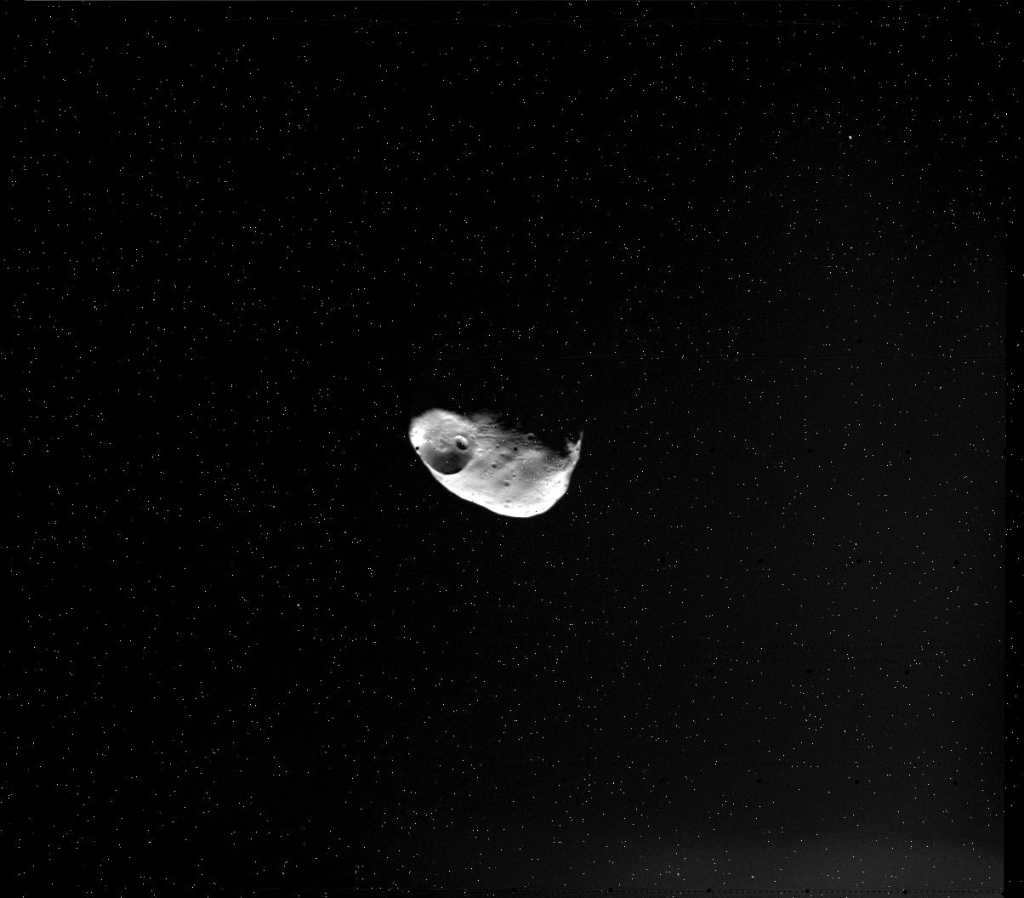
The image shows Phobos, one of the satellites of Mars, and it was taken by the Viking Orbiter 1 spacecraft on September 16, 1976.
Both satellites possess orbits that are nearly circular and lie almost exactly in Mars’ equatorial plane. This suggests that in order to be captured, they must have initially traveled in a highly elongated orbit, which subsequently transformed into its current shape due to the planet’s atmospheric resistance and tidal forces. The process of Deimos’ capture remains unclear. Capture itself necessitates the dissipation of energy during the transition to another orbit, but Mars’ current atmosphere is insufficiently dense to capture an object like Phobos through atmospheric braking. Astronomer Jeffrey Landis proposed that the capture could have occurred if the original body was a binary asteroid that later separated as a result of the planet’s tidal forces.
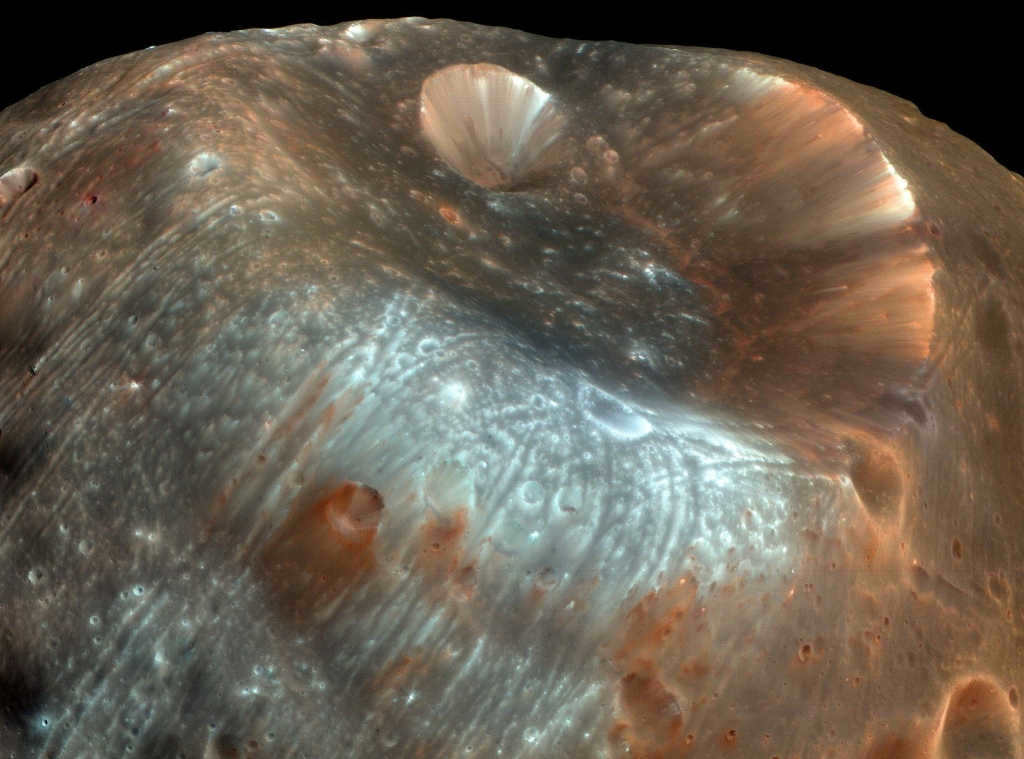

This image has been enhanced to highlight its colors and provide better contrast.
Phobos could potentially be a secondary object, indicating that it might have originated within the orbit of the planet after Mars itself had already formed, rather than forming simultaneously with the planet.
Formation Hypothesis Alternative
Phobos’ solar eclipse animation
There is another theory regarding the formation of Mars’ satellites, suggesting that the planet was once surrounded by numerous bodies similar in size to the current satellites. These bodies were thrown into Mars’ orbit as a result of a collision with a large planetesimal. However, Phobos’ high porosity, with a density of 1.88 g/cm3 and voids accounting for 25 to 35 percent of its volume, does not support the idea of an asteroidal origin.
Research conducted on Phobos’ infrared spectrum reveals a significant presence of phyllosilicates, which are commonly found on the surface of Mars. This spectral composition differentiates Phobos from all classes of chondrites, which are meteorites of asteroidal origin. Based on these observations, it is believed that Phobos formed from material that was ejected into Mars’ orbit following a collision with an asteroid or another large celestial body.
Martian Solar Eclipses
A stunning occurrence of a solar eclipse on the red planet, featuring the Martian moon Phobos
An alternative perspective of the extraordinary celestial phenomenon
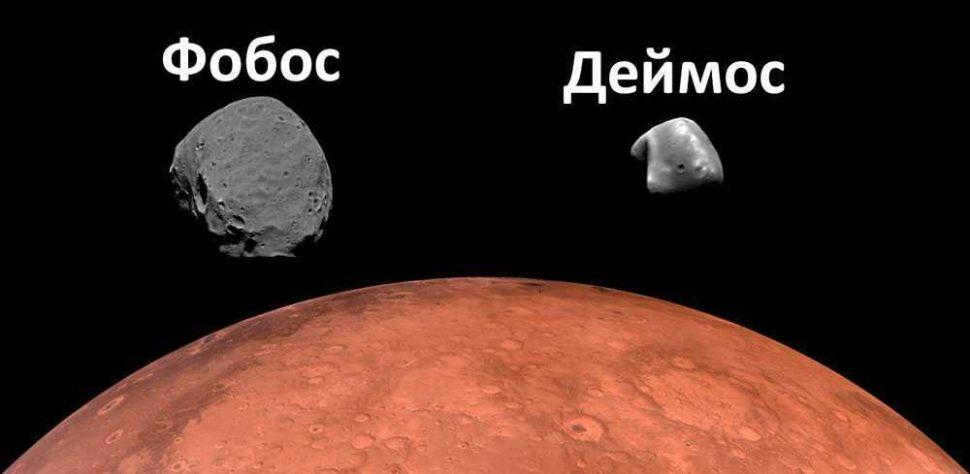
Mars is the seventh largest planet in our solar system. This celestial body, also known as the Red Planet, is situated at an average distance of approximately 228 million kilometers from the Sun. Mars belongs to the category of Earth-like planets, and it stands out because of its unique reddish hue. Scientists are particularly intrigued by Mars due to its similarities to our own planet, which has led to speculations about the possibility of utilizing Mars for various purposes or even establishing human settlements there in the future. In the vastness of space, Mars is accompanied by two natural satellites, namely Phobos and Deimos.
Let’s acquaint ourselves with each of the satellites of the crimson planet in greater depth, explore their primary attributes, source, discovery history, research, and more.
Phobos Characteristics
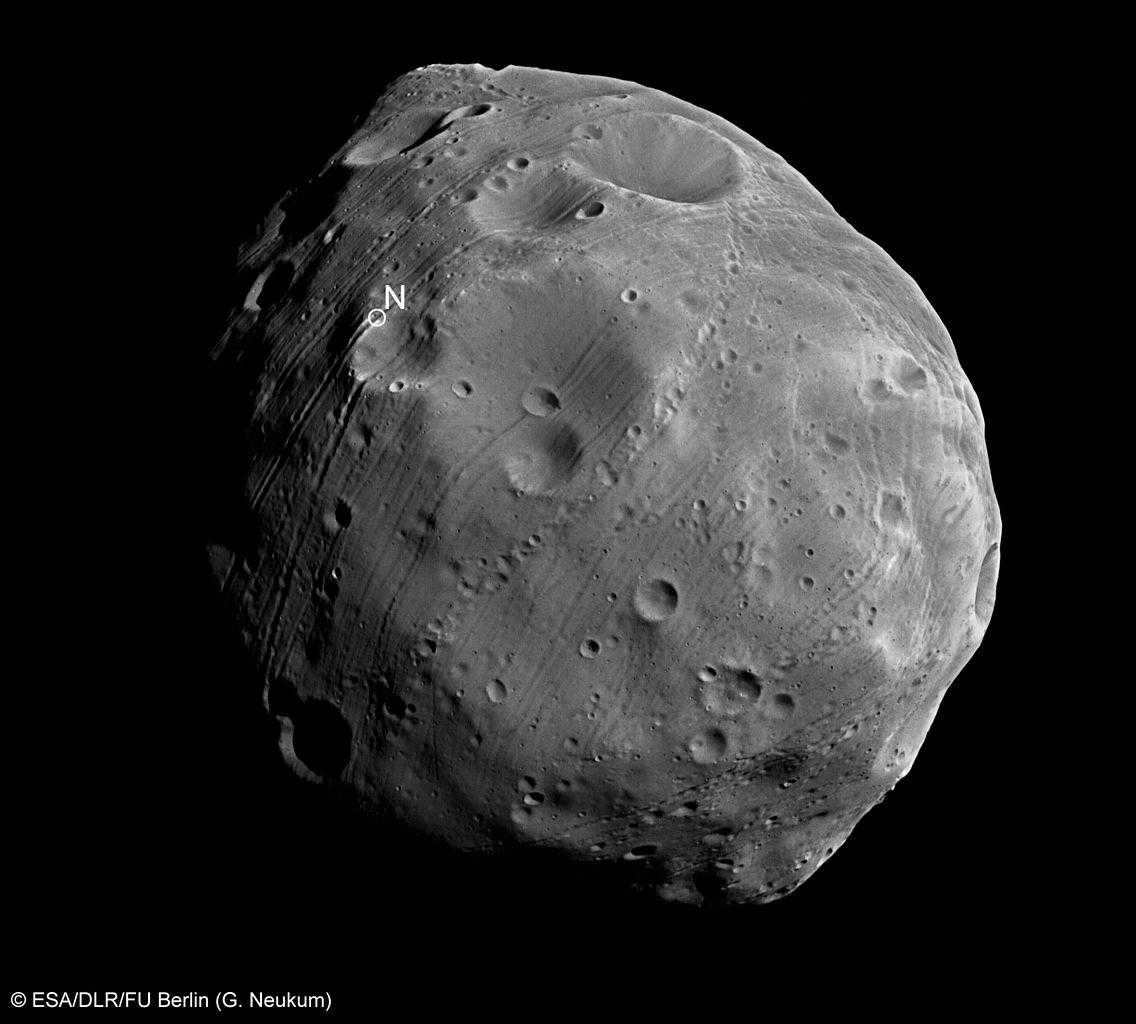
The Martian moon, Phobos, orbits around Mars at a distance of 6006 km, if measured from the surface of the red planet, and completes a full revolution around Mars in 7 hours, 39 minutes, and 12 seconds. Despite being the largest of Mars’ satellites, Phobos has a relatively small diameter of only 22.5 km. In comparison, the average diameter of Earth’s moon is approximately 3474.1 km.
Due to its low mass of 1.072×10 16 kg, Phobos lacks an atmosphere. The influence of Martian gravity causes Phobos to gradually slow down, bringing it closer to the surface of Mars. Eventually, the natural satellite will collide with Mars, though it is likely that Phobos will disintegrate under the effects of tidal forces long before the catastrophic impact occurs.
There is an assumption that the Martian moon Phobos has a cavity occupying about 25 to 45% of its interior. On the surface of Phobos, one can observe a number of deep and unique grooves that are located near the prominent feature of Phobos – Stickney crater. This crater, which is named after Asaph Hall’s wife who discovered both Martian moons, is believed to have been formed due to a collision with an asteroid, given its 9 km diameter.
The surface of Phobos is coated with a dense layer of Regolith. It’s fascinating to note that there is a hypothesis suggesting that the Kaidong meteorite originated from Phobos and made its way to Earth. In 1980, a meteorite fell in the People’s Democratic Republic of Yemen and it was found to contain elements that support the theory of Kaidun having a Martian origin. It is believed that during a collision with another celestial body, material from Mars got dislodged and traveled to its larger moon, undergoing transformations before eventually forming into the meteorite we are familiar with.
Table 1: Fundamental physical properties of Phobos
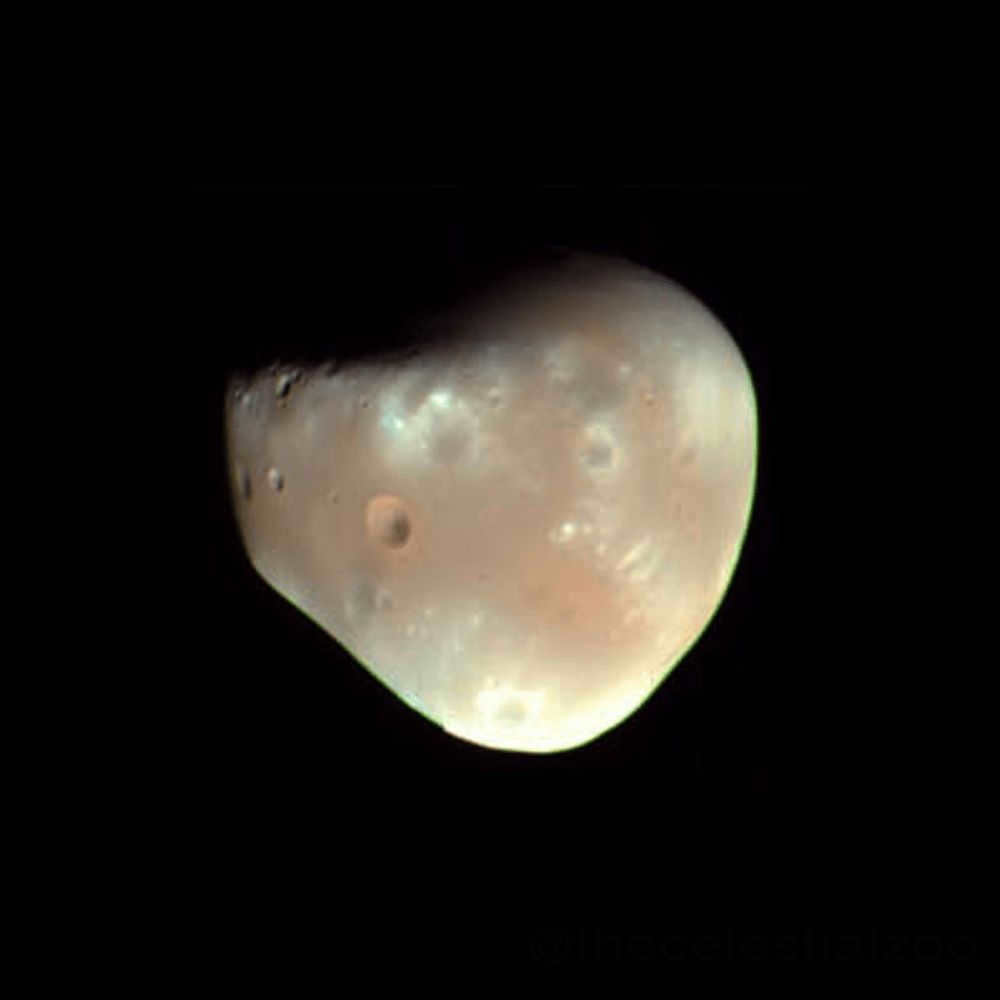
Deimos has a diameter that is nearly half the size of its larger sibling, measuring at 12.4 kilometers. This second moon of Mars follows an orbital path around the planet for a total of 30 hours, 17 minutes, and 55 seconds, at a distance of 23,458 kilometers. While Deimos was once considered the smallest moon in our entire solar system, it has since been discovered that there are other satellites that are even smaller in size.
The orbit of this moon is nearly circular in shape. In contrast to Phobos, which rises in the west and sets in the east on Mars, Deimos behaves in the opposite manner, rising in the east and setting in the west.
Moreover, in contrast to Phobos, which moves closer to Mars each year, Deimos is gradually moving away from the red planet. It is highly probable that in the future it will escape the orbit of the fourth planet of our solar system and venture into space as an independent celestial body.
Deimos has a more uniform surface compared to Phobos, with only two prominent features: the Swift crater, measuring 1 km in diameter, and the Voltaire crater, measuring 1.9 km in diameter. These craters were named after two writers who predicted the existence of such satellites in their works. One would expect Deimos to have numerous imperfections on its surface due to solar wind, radiation, and collisions with other objects, but surprisingly, this is not the case.
Deimos and Phobos possess a distinct shape that sets them apart from both the planets and other moons within our Solar System.
Table 3: Primary physical attributes of Deimos
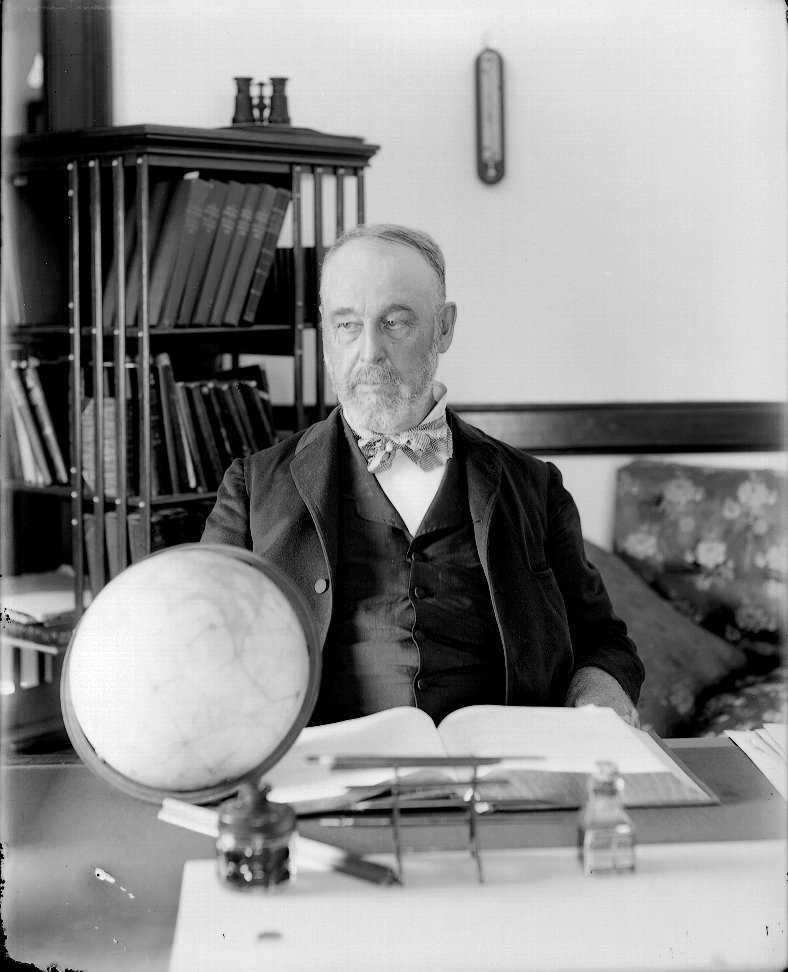
Approximately four centuries ago, the renowned German scientist Johannes Kepler proposed the notion that Mars might possess two satellites. This concept was influenced by the fact that our own planet has a moon, as well as Galileo’s discovery of four satellites orbiting Jupiter. The idea that the red planet could be accompanied by two satellites aligned with Johannes Kepler’s belief in the natural harmony and balance that permeates the universe.
Deimos and Phobos were officially identified in 1877 with a span of six days between their discoveries – Deimos on August 11th and Phobos on August 17th. These names were derived from Homer’s epic poem “The Iliad”, with Henry George Madan making the suggestion.
Legends and Folklore
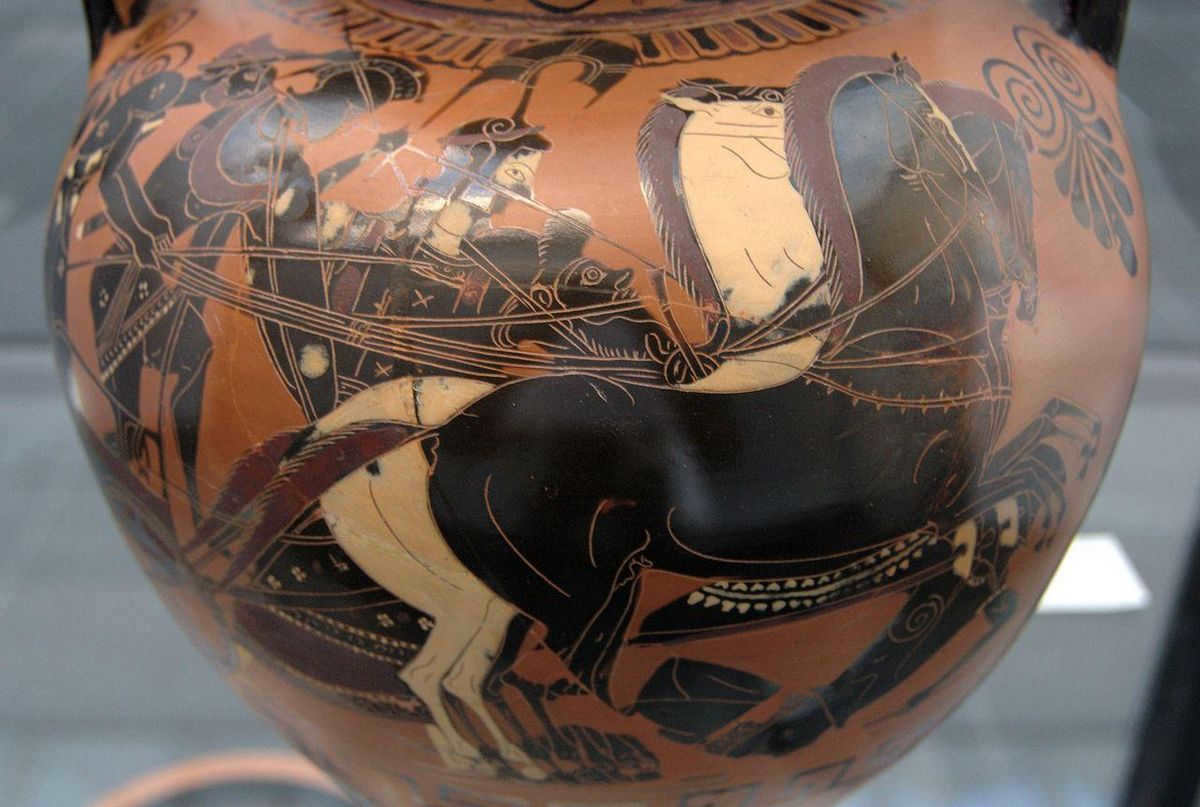
Ares, the offspring of Zeus and Hera, was the deity of warfare and one of the divine beings of Olympus. This ancient Greek deity existed solely for the purpose of engaging in battles and was dedicated to making war as bloody and deceitful as conceivable. In the Roman mythos, Ares was the equivalent of Mars.
Aphrodite, the goddess of beauty, was enamored with Ares and they eventually bore offspring:
- Eros – the deity of love and assistant to Aphrodite.
- Harmonia – the goddess of harmony and blissful matrimony.
- Pophos – the deity of yearning love.
- Himeros – the patron and deity of love.
- Anteros – patronizes reciprocal love, but seeks revenge on those who do not reciprocate love and mocks the emotions of others.
- Phobos – the deity of fear, who accompanied his father in battles.
- The last two brothers were honored by being named satellites of Mars, and the metaphorical connection between celestial bodies and mythological events can certainly be seen.
In honor of the last two brothers and were named satellites of Mars, and the metaphorical connection of celestial bodies with the events of myths is definitely traceable.
Visibility from Mars
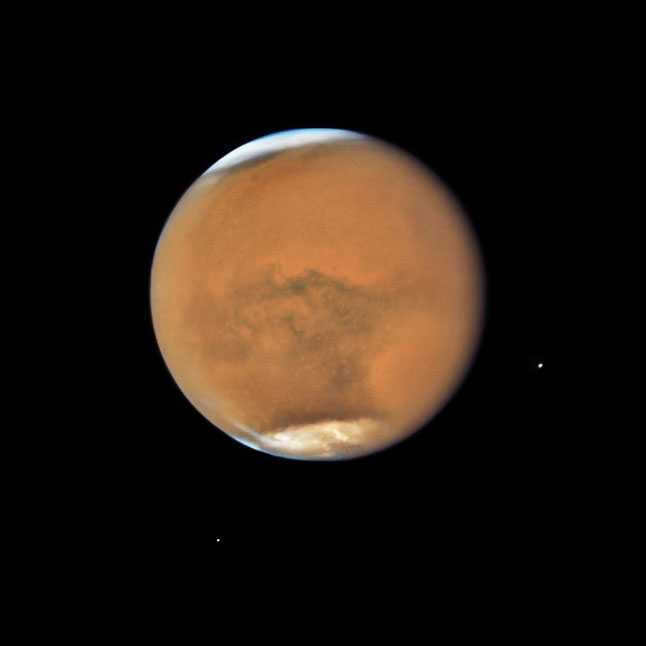
Both the satellites, Phobos and Deimos, can be seen from Mars. The closer the observer is to the equator, the better visibility they have. However, at the poles of the planet, neither Deimos nor Phobos can be seen at all.
Both Phobos and Deimos always show the same side to the red planet. Phobos appears like a moon from the surface of the planet, but it is three times smaller in size. On the other hand, Deimos resembles a star due to its smaller size and farther distance.
Source
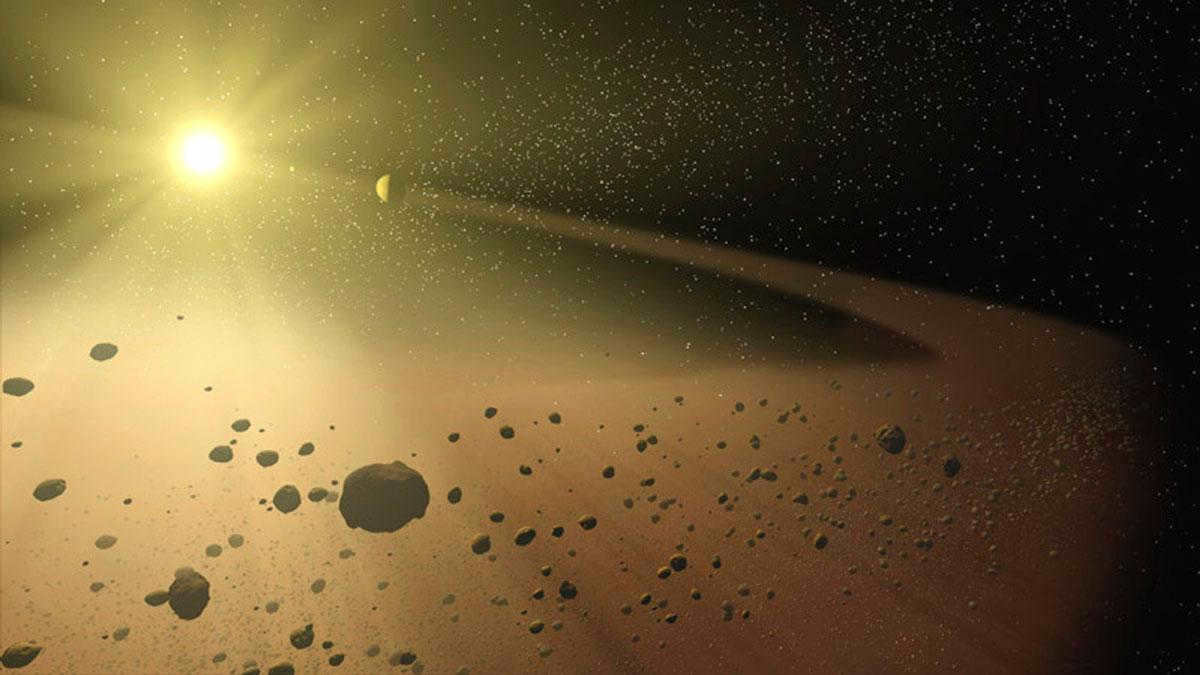
There are numerous theories about the origin of Phobos and Deimos:
- Firstly, it is suggested that both satellites were originally asteroids from the Asteroid Belt and later became the moons of Mars. However, there are two arguments against this theory: the improbability of Mars capturing two asteroids simultaneously and the differences in composition between the satellites and the asteroids in the Belt.
- Alternatively, it is proposed that Phobos and Deimos were once part of a single large asteroid that subsequently split into two satellites orbiting the red planet. However, the low density of Phobos and Deimos, along with their orbits above the equator of Mars, do not support this hypothesis.
- Furthermore, the moons of Mars are believed to have formed as a result of a massive collision between the planet and another celestial body. This collision caused a portion of Mars to be ejected into orbit, ultimately forming the moons we see today. The similarity in composition between the satellites and Mars itself provides additional support for this theory.
In addition to these prevailing theories, there is also a hypothesis suggesting the possible existence of a third moon of Mars. Some scientists propose that this hypothetical moon, known as Thanatos, was destroyed as a result of interactions with the massive planet. The destruction of Thanatos would have had significant consequences for the Martian landscape and atmosphere, potentially even leading to the extinction of any living organisms that may have once inhabited Mars.
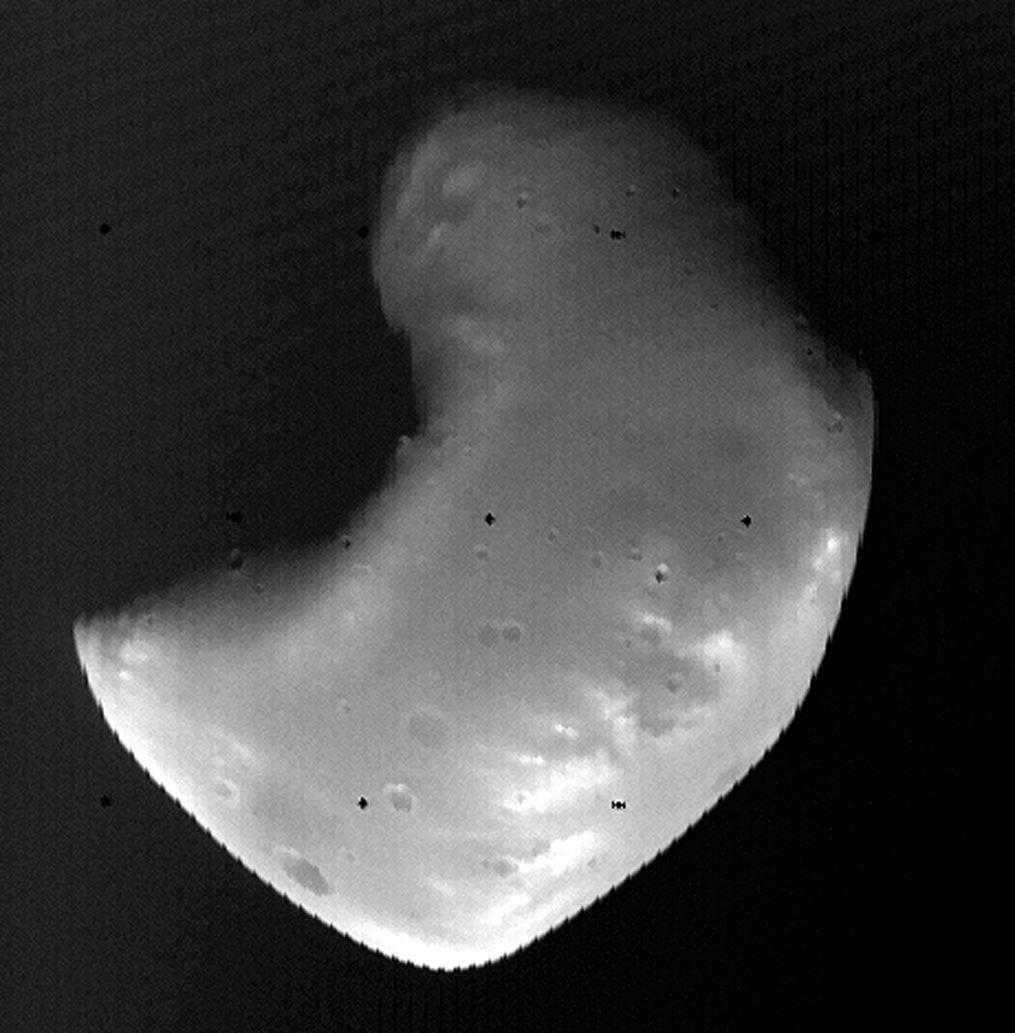
A significant number of exploration missions have not achieved their objectives. Nevertheless, humanity has still managed to acquire knowledge about the moons of Mars.
As far back as 1894, Belopolsky successfully captured images of Deimos. Kostinsky also obtained photographs of the satellites in 1909 and 1896.
In 1911, Struve put forward a theory regarding the movement of Phobos and Deimos.
On March 27th, 1969, the Mariner 7 interplanetary spacecraft was launched. It captured several photos of the Martian surface, including a shadow cast by Phobos.
A few years later, a new spacecraft was developed. Mariner-9 was launched on May 31, 1971, with the purpose of exploring the red planet. Interestingly, this interplanetary spacecraft was the first man-made satellite to venture beyond Earth’s orbit. It successfully took images of Phobos and Deimos themselves.
After a span of six years, precisely in 1977, Viking-1 and Viking-2, two orbital stations, provided us with fresh images of the red planet’s moons.
The year 1988 witnessed the launch of two Soviet automatic interplanetary stations. Phobos-1 and Phobos-2 were not only designed to explore the fourth planet of the Solar System and its satellites, but also to investigate the Sun, interplanetary shock waves, and other celestial bodies. While the first spacecraft managed to gather some information about our star, the connection with the station was lost shortly after. Phobos-2, on the other hand, captured a few images, but it failed to accomplish the main objective of the mission: landing on the surface of the larger moon of the red planet.
Ten years later, a new interplanetary station was sent into space, this time by the United States. The primary objective of the mission was to create a detailed map of Mars, a goal that had already been accomplished in 2001. However, even after this milestone, the spacecraft remained in operation until 2006, when contact with the station was lost.
In 2003, another interplanetary station was launched from the Baikonur Cosmodrome and is still functioning today. This spacecraft was dedicated to studying Mars and made significant discoveries, including the detection of methane in the planet’s atmosphere and the presence of frozen water. Additionally, the Mars Express, as it was named, captured several images of Phobos, one of Mars’ moons.
Furthermore, images of Phobos were also acquired by the U.S. Mars Reconnaissance Orbiter in 2007 and once again in 2008.
Originally launched in 2001, Mars Odyssey conducted measurements of the surface temperature of Phobos while it was exposed to full sunlight. During solar illumination, the temperature on the Celsius scale reached twenty-seven degrees, while without sunlight, it plummeted to one hundred and twenty-three degrees below zero.
Fast forward to January 9, 2011, and the Mars Express once again made a remarkable achievement by capturing images of Phobos, coming incredibly close to the celestial body.
In that very same year, there was an ambitious attempt to send a spacecraft to Earth carrying soil samples from both Mars and Phobos. Unfortunately, the Russian Phobos-Grunt automatic interplanetary station failed to escape Earth’s orbit and ultimately disintegrated in the atmosphere in 2012.
The Japanese Aerospace Exploration Agency is currently working on the development of a groundbreaking spacecraft called Martian Moons Exploration. This innovative spacecraft is set to be launched in September 2024 with the mission of exploring the satellites of Mars and collecting soil samples from Phobos. These samples will then be brought back to Earth in 2029, marking a significant milestone in space exploration.
Occurrences of Eclipses on Mars
Similar to our own planet, Mars also experiences solar eclipses. However, due to the smaller size and faster orbit of its moon Phobos, these celestial events are typically brief, lasting no more than twenty seconds.
